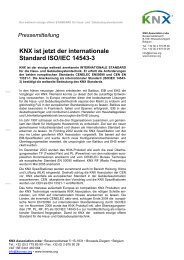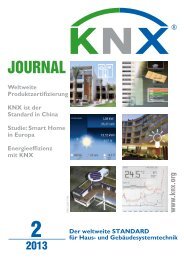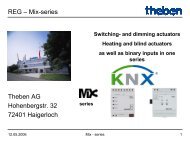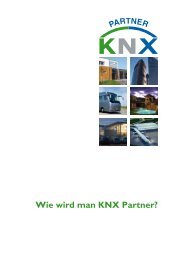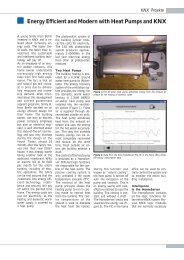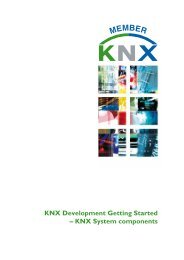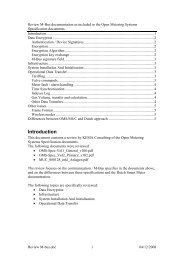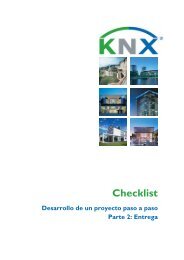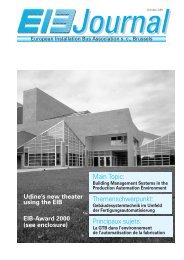KNX Journal 2011-1
KNX Journal 2011-1
KNX Journal 2011-1
Create successful ePaper yourself
Turn your PDF publications into a flip-book with our unique Google optimized e-Paper software.
<strong>KNX</strong> Projects<br />
Improving the energy efficiency of an apartment<br />
in an old building in Berlin<br />
Energy-efficient building of historic importance<br />
Old buildings are beautiful,<br />
but they are rarely<br />
well insulated. However,<br />
improving the “interior energy<br />
efficiency” significantly<br />
reduces heating costs and<br />
CO 2<br />
emissions. Home automation<br />
systems, such as<br />
Synco living from Siemens<br />
Building Technologies Division,<br />
play an important role<br />
in this process, as this case<br />
study of an apartment in an<br />
old building in Berlin shows<br />
The Radetzky family has been<br />
living for several years in a 180<br />
m² apartment on the second<br />
floor of an old building in Berlin’s<br />
Kreuzberg district. The building<br />
was constructed in 1906 right<br />
next to a church. Its brick walls<br />
and neo-gothic facade with high<br />
lancet windows reflect the<br />
sacral architecture of the time<br />
to great effect. Today, it is listed<br />
as a historic building.<br />
Since preservation regulations<br />
stipulate that the facade of this<br />
historic building be kept as is, the<br />
exterior walls lack insulation.<br />
Despite several renovations,<br />
the building’s thermal insulation<br />
standard is low. For this reason,<br />
Thomas Radetzky began to<br />
take measures to improve the<br />
interior energy efficiency of his<br />
family’s apartment: In several<br />
steps he installed the electronic<br />
home automation system Synco<br />
living from Siemens Building<br />
Technologies Division. At the<br />
same time, he carefully logged<br />
his family’s consumption of natural<br />
gas and electricity before<br />
and after installing the various<br />
system components.<br />
Building services and<br />
Synco living<br />
Rooms are heated with a hotwater<br />
radiator system (singlepipe<br />
system; flow temperature<br />
limited to a maximum of 75°C).<br />
The heating curve is controlled<br />
based on the outside temperature.<br />
Heat is generated by<br />
a natural gas boiler installed<br />
in 2003. It also functions as a<br />
Picture 1.<br />
View of building from the south<br />
Picture 2.<br />
Synco living central apartment unit<br />
with display and operating panels<br />
Tab. 1. Physical characteristics of the building and heating systems<br />
Characteristic<br />
Explanation<br />
Location<br />
Berlin Kreuzberg<br />
Heating degree value<br />
20/15 (1970-2008)<br />
3.615 Kd/a For a room temperature of<br />
20°C, heating limit of 15°C<br />
Year built 1906<br />
Last renovated - Historical building<br />
Use Residential<br />
Usable space 180<br />
Usage units, total 28 Multi-family building<br />
Physical characteristics and heating:<br />
Thermal insulation none<br />
standard<br />
k-value – exterior wall ~ 1,7 W/m² K Brick, 24 cm, not insulated<br />
k-value – windows ~ 2,5 W/m² K Compound windows, wood<br />
frames with significant leaks<br />
Heat generator, power 16,8 kW Natural gas, wall-mounted<br />
boiler (2003 model)<br />
Domestic hot water<br />
heating<br />
central Natural gas, tankless water<br />
heater<br />
tankless water heater for domestic<br />
hot water. In December<br />
of 2006, the family installed<br />
Synco living radiator controls<br />
with wireless technology in<br />
all rooms. For each room,<br />
Radetzky programmed the<br />
target temperatures to match<br />
the times when the room is<br />
actually being used. The central<br />
unit was preset to 24°C for<br />
Comfort mode and to 18°C<br />
for Eco mode. If desired, these<br />
temperature presets can<br />
easily be overridden on an<br />
individual basis. Settings can<br />
be programmed quickly and<br />
easily on the central apartment<br />
unit (picture 2), and they can<br />
be modified remotely from a<br />
cellular phone.<br />
Energy consumption<br />
Assuming the energy consumption<br />
for domestic hot<br />
water heating has remained<br />
the same, the recorded values<br />
show a significant reduction in<br />
electrical heat release during<br />
the 2008/09 heating season.<br />
For room heating, a savings<br />
of approximately 28 % was<br />
achieved. In the same time<br />
period, natural gas and electricity<br />
requirements for heating<br />
and hot water were reduced<br />
by 21 % and 10 % respectively<br />
as compared to the two-year<br />
average without Synco living.<br />
The data shows that the<br />
significant benefits of timeand<br />
room-based on-demand<br />
heating control using Synco<br />
living are directly linked to the<br />
insufficient thermal insulation<br />
of the historical facade and<br />
the major transmission and<br />
ventilation heat losses resulting<br />
from it. In addition, the<br />
operation of the natural gas<br />
boiler has been load-based<br />
(modulating) since 2007, which<br />
also contributed significantly<br />
to the reduction in consumption.<br />
Combining electricity and<br />
gas consumption into primary<br />
energy consumption after applying<br />
the respective coefficient<br />
(2.7 and 1.1) results in the situation<br />
shown in figure 4. This<br />
16 <strong>Journal</strong> 1/<strong>2011</strong>




